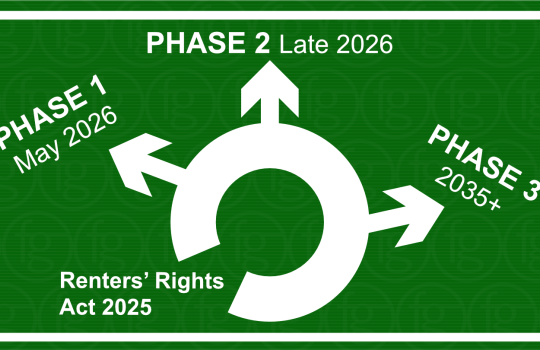Renters’ Rights Act and Section 8

The Renters’ Rights Act 2025, which received Royal Assent on 27 October, marks the most significant reform of England’s rental market in decades. Designed to give tenants greater security and stability, the Act abolishes Section 21 ‘no-fault’ evictions and introduces an expanded Section 8 framework for possession under the Housing Act 1988. In this article, Fuller Gilbert examines what these changes mean for landlords and tenants.
The long-awaited legislation ends Section 21 notices, meaning landlords can no longer evict tenants without a valid reason. Instead, all assured shorthold tenancies will convert into open-ended periodic tenancies, rolling month to month without a fixed term. Landlords seeking possession must rely on Section 8 grounds (outlined later in this article), which have been updated with longer notice periods and new restrictions.
Although the Act is now law, the changes will not take effect immediately. The government expects implementation from mid-2026, with detailed guidance to follow.
Key updates include:
- Protected period: Certain “no-fault” grounds (e.g., sale or moving in) cannot be used in the first 12 months of a tenancy.
- Notice periods: Most non-fault grounds now require 4 months’ notice; rent arrears grounds require 4 weeks.
- Tenant rights: Tenants can end a tenancy at any time with two months’ notice.
- Additional reforms: A new landlord database, mandatory redress scheme, ban on discrimination (benefits or children), right to request pets, and application of the Decent Homes Standard.
- Tenant protections: Ban on discrimination (benefits or children), right to request pets, and application of Awaab’s Law to the private rented sector.
Tenant groups have welcomed the changes as a step toward stability and protection from sudden evictions . However, some landlords warn it could make it harder to regain properties quickly or deal with problematic tenants. The government says the new law strikes a fair balance - offering renters greater security while still allowing landlords to recover homes when they have a legitimate reason.
| Feature - scroll to continue with content... |
| continue reading article... |
Understanding Section 8 Grounds for Possession
Section 8 grounds fall into two categories:
- Mandatory grounds: If proven, the court must grant possession.
- Discretionary grounds: The court may grant possession if it considers it reasonable.
Mandatory Grounds (Grounds 1–8, 1A, and 7A)
If a landlord proves a mandatory ground and meets statutory requirements, the court must make a possession order. Under the Renters’ Rights Act, most notice periods for non-fault grounds have increased to 4 months, and landlords cannot use certain grounds within the first 12 months of a tenancy (the “protected period”).
Key Mandatory Grounds
- Ground 1: Landlord’s Return
Landlord previously lived in the property as their only or principal home and wishes to return.
Conditions: Notice must have been given before the tenancy began; cannot be used in first 12 months.
Notice: 4 months.
- Ground 1A: Sale of Property (New Ground)
Landlord intends to sell the property.
Conditions: Cannot be used in first 12 months; restrictions on re-letting after sale.
Notice: 4 months.
- Ground 2: Mortgage Repossession
Property subject to a mortgage granted before the tenancy; lender requires possession.
Notice: 4 months.
- Ground 3: Holiday Let
Fixed-term tenancy (not exceeding 8 months) where property was a holiday let within 12 months before tenancy.
Notice: 2 weeks.
- Ground 4: Educational Institution Let
Fixed-term tenancy (not exceeding 12 months) let by or for an educational institution.
Notice: 2 weeks.
- Ground 5: Religious Use
Property held for occupation by a minister of religion; notice given before tenancy began.
Notice: 4 months.
- Ground 6: Demolition / Redevelopment
Landlord intends substantial works or demolition.
Notice: 4 months.
- Ground 7: Death of Tenant
Tenancy devolved under will or intestacy; proceedings within 12 months of death or landlord’s awareness.
Notice: 2 months.
- Ground 7A: Serious Anti-Social Behaviour
Covers serious criminal or anti-social behaviour (e.g., violence, drug offences, breach of injunctions).
Notice: Immediate.
- Ground 8: Serious Rent Arrears
Tenant owes at least 3 months’ rent at notice and hearing dates.
Notice: 4 weeks.
| Feature - scroll to continue with content... |
| continue reading article... |
Discretionary Grounds (Grounds 9–17)
The court decides based on reasonableness, considering factors such as seriousness, tenant’s circumstances, and efforts to remedy breaches.
Key Discretionary Grounds
- Ground 9: Suitable Alternative Accommodation
Landlord offers suitable alternative housing.
Notice: 2 months.
- Ground 10: Some Rent Arrears
Rent lawfully due at notice and hearing (below Ground 8 threshold).
Notice: 4 weeks.
- Ground 11: Persistent Late Payment
Tenant persistently delays rent payments.
Notice: 4 weeks.
- Ground 12: Breach of Tenancy Terms
Any non-rent breach (e.g., unauthorised pets, subletting).
Notice: 4 weeks.
- Ground 13: Deterioration of Property
Damage or neglect by tenant or household.
Notice: 4 weeks.
- Ground 14: Anti-Social Behaviour / Nuisance
Nuisance, annoyance, illegal or immoral use.
Notice: Immediate.
- Ground 14A: Domestic Abuse (Social Housing Only)
One partner leaves permanently due to violence or threats.
Notice: 2 weeks.
- Ground 15: Damage to Furniture
In furnished property, tenant damages furniture beyond normal wear.
Notice: 4 weeks.
- Ground 16: Employment-Linked Tenancy
Tenancy linked to employment that has ended.
Notice: 2 months.
- Ground 17: False Statements
Tenant obtained tenancy through false statements.
Notice: 4 weeks.
Serving a Valid Section 8 Notice
To start possession proceedings:
- Use Form 3 (prescribed Section 8 notice).
- State the ground(s) and include full wording.
- Give correct notice period and specify earliest court date.
- Ensure compliance with other legal requirements (e.g., deposit protection).
- Gather supporting evidence (rent statements, photos, witness statements).
- Errors can invalidate the notice, causing delays.
After Serving the Notice
- Tenant Response: Tenant may leave, negotiate, or dispute grounds.
- Court Application: If tenant stays, landlord applies for possession order.
- Court Hearing: Mandatory grounds = court must grant possession; discretionary = court decides reasonableness.
- Enforcement: If tenant still refuses, landlord applies for warrant for bailiffs.
- Typical timeline: 8–12 weeks for straightforward cases; longer if contested.
Final Thoughts
The Section 8 route is a powerful legal tool for landlords when the correct grounds apply—but it must be used with care. Understanding the correct ground, serving the notice properly, observing the correct notice period, and building a strong evidence base are all essential for success.
For tenants, awareness of the grounds, timing, potential defences (for example, invalid notice, fairness of the grounds, mitigating circumstances) and rights to negotiate or defend is equally important.
If either party is uncertain, professional legal advice is strongly recommended.
This article is intended as a general guide for informational purposes and will be updated as further details become available. Always seek professional advice before making any property and/or financial decisions.
Related Reads
October 2025: https://www.fullergilbert.co.uk/renters-rights-bill-ready
April 2025: https://www.fullergilbert.co.uk/renters-rights-bill-invokes-lively-committee-debate
April 2025: https://www.fullergilbert.co.uk/renters-rights-bill-scrutinised
March 2025: https://www.fullergilbert.co.uk/leasehold-system-reforms-move-a-step-closer
Jan 2025: https://www.fullergilbert.co.uk/renters-rights-bill-progresses
Click here for the Government's guide to the Renters’ Rights Act
















